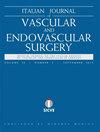Surgical outcomes of carotid body tumors removal and analysis of cardinal predictors associated with neurovascular and bleeding complications
IF 0.2
Q4 PERIPHERAL VASCULAR DISEASE
Italian Journal of Vascular and Endovascular Surgery
Pub Date : 2023-10-01
DOI:10.23736/s1824-4777.23.01583-8
引用次数: 0
Abstract
BACKGROUND: Improvement of existing forecasting tools for prediction of neurovascular and bleeding complications associated with carotid body tumors (CBTs) surgery and construction of novel predictive systems.METHODS: Medical records of patients who underwent CBT excision from 2011 to 2021 were retrospectively reviewed for perioperative information. The retrospective analysis was combined with confirmational prospective telephone survey of each patient for improvement of collected descriptive data quality.RESULTS: A total of 58 tumors were removed per 55 excisions. According to Shamblin’s classification, 34.5% of removed CBTs referred to grade I, 60% were grade II and only 5.5% belonged to grade III. The median tumor volume was 14.8 cm3 (interquartile range [IQR] 8.1-24.5 cm3). The mean distance from tumor apex to the base of skull (DTBOS) was 4.1±1.4 cm. The median estimated blood loss (EBL) was 200 mL (IQR 50-400 mL). The overall 30-day cranial nerve (CN) dysfunction rate after surgery was 60%. The overall 30-day mortality and 30-day stroke rate were 0% and 1.8%, respectively. The regression analysis revealed statistically significant (P<0.001) association between tumor volume and EBL with explicit positive linear trend (y = 76.95 + 9.22 x) and acceptable predictive strength (R2=0.368). Obvious negative correlation (P<0.001, R2=0.225) was discovered between tumor distance to base of skull (DTBOS) and overall amount of damaged CNs.CONCLUSIONS: Approximately 37% of differences in EBL can be explained by the differences in tumor volume. Approximately 23% of differences in overall amount of damaged CNs can be explained by the differences in DTBOS.颈动脉体肿瘤切除的手术结果及与神经血管和出血并发症相关的主要预测因素分析
背景:改进现有预测工具,预测颈动脉体肿瘤(CBTs)手术相关的神经血管和出血并发症,构建新的预测系统。方法:回顾性分析2011年至2021年接受CBT切除术患者的病历,以获取围手术期信息。回顾性分析与每位患者的前瞻性电话调查相结合,以提高收集到的描述性数据的质量。结果:每55次手术共切除58个肿瘤。根据Shamblin的分类,被移除的cbt中34.5%属于I级,60%属于II级,只有5.5%属于III级。中位肿瘤体积为14.8 cm3(四分位数间距[IQR] 8.1-24.5 cm3)。肿瘤顶点至颅底的平均距离(DTBOS)为4.1±1.4 cm。估计中位失血量(EBL)为200 mL (IQR 50-400 mL)。术后30天总颅神经功能障碍率为60%。总的30天死亡率和30天中风率分别为0%和1.8%。回归分析显示肿瘤体积与EBL呈正相关(P<0.001),呈明显的正线性趋势(y = 76.95 + 9.22 x),可接受的预测强度(R2=0.368)。肿瘤至颅底距离(DTBOS)与中枢神经系统总损伤量呈显著负相关(P<0.001, R2=0.225)。结论:大约37%的EBL差异可以用肿瘤体积的差异来解释。受损中枢神经系统总量的差异中约有23%可以用DTBOS的差异来解释。
本文章由计算机程序翻译,如有差异,请以英文原文为准。
求助全文
约1分钟内获得全文
求助全文
来源期刊

Italian Journal of Vascular and Endovascular Surgery
PERIPHERAL VASCULAR DISEASE-
CiteScore
1.00
自引率
0.00%
发文量
27
审稿时长
>12 weeks
期刊介绍:
The Italian Journal of Vascular and Endovascular Surgery publishes scientific papers on vascular surgery. Manuscripts may be submitted in the form of editorials, original articles, review articles, case reports, therapeutical notes, special articles and letters to the Editor.
 求助内容:
求助内容: 应助结果提醒方式:
应助结果提醒方式:


